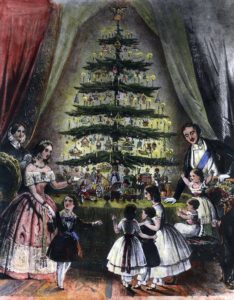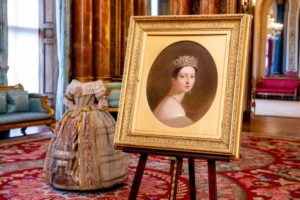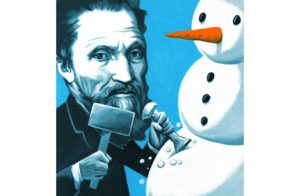From Saturnalia to Christmas Eve, people have always had a spiritual need for greenery in the depths of winter
The Wall Street Journal, December 13, 2018

Queen Victoria and family with their Christmas tree in 1848. PHOTO: GETTY IMAGES
My family never had a pink-frosted Christmas tree, though Lord knows my 10-year-old self really wanted one. Every year my family went to Sal’s Christmas Emporium on Wilshire Boulevard in Los Angeles, where you could buy neon-colored trees, mechanical trees that played Christmas carols, blue and white Hanukkah bushes or even a real Douglas fir if you wanted to go retro. We were solidly retro.
Decorating the Christmas tree remains one of my most treasured memories, and according to the National Christmas Tree Association, the tradition is still thriving in our digital age: In 2017 Americans bought 48.5 million real and artificial Christmas trees. Clearly, bringing a tree into the house, especially during winter, taps into something deeply spiritual in the human psyche.
Nearly every society has at some point venerated the tree as a symbol of fertility and rebirth, or as a living link between the heavens, the earth and the underworld. In the ancient Near East, “tree of life” motifs appear on pottery as early as 7000 B.C. By the second millennium B.C., variations of the motif were being carved onto temple walls in Egypt and fashioned into bronze sculptures in southern China.
The early Christian fathers were troubled by the possibility that the faithful might identify the Garden of Eden’s trees of life and knowledge, described in the Book of Genesis, with paganism’s divine trees and sacred groves. Accordingly, in 572 the Council of Braga banned Christians from participating in the Roman celebration of Saturnalia—a popular winter solstice festival in honor of Saturn, the god of agriculture, that included decking the home with boughs of holly, his sacred symbol.
It wasn’t until the late Middle Ages that evergreens received a qualified welcome from the Church, as props in the mystery plays that told the story of Creation. In Germany, mystery plays were performed on Christmas Eve, traditionally celebrated in the church calendar as the feast day of Adam and Eve. The original baubles that hung on these “paradise trees,” representing the trees in the Garden of Eden, were round wafer breads that symbolized the Eucharist.
The Christmas tree remained a northern European tradition until Queen Charlotte, the German-born wife of George III, had one erected for a children’s party at Windsor Castle in 1800. The British upper classes quickly followed suit, but the rest of the country remained aloof until 1848, when the London Illustrated News published a charming picture of Queen Victoria and her family gathered around a large Christmas tree. Suddenly, every household had to have one for the children to decorate. It didn’t take long for President Franklin Pierce to introduce the first Christmas tree to the White House, in 1853—a practice that every President has honored except Theodore Roosevelt, who in 1902 refused to have a tree on conservationist grounds. (His children objected so much to the ban that he eventually gave in.)
Many writers have tried to capture the complex feelings that Christmas trees inspire, particularly in children. Few, though, can rival T.S. Eliot’s timeless meditation on joy, death and life everlasting, in his 1954 poem “The Cultivation of Christmas Trees”: “The child wonders at the Christmas Tree: / Let him continue in the spirit of wonder / At the Feast as an event not accepted as a pretext; / So that the glittering rapture, the amazement / Of the first-remembered Christmas Tree /…May not be forgotten.”








